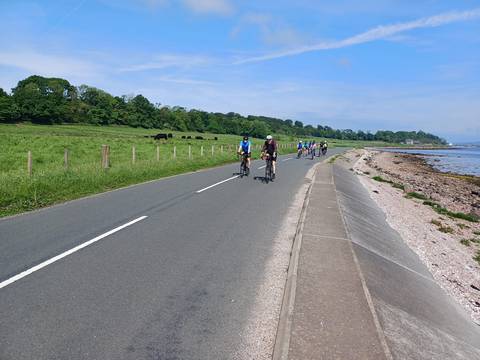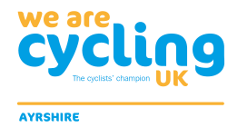Group Cycling Guidelines
Mandatory :
Cycles must be legal and roadworthy.If the bicycle does not appear to be roadworthy, the leader may refuse to allow you to join the group.
Recommended
As a minimum, you should consider carrying:- spare tube(s) and puncture repair kit, pump, tyre levers.
- some drink, food and money for emergencies.
- when necessary, wet weather wear and warm clothing.
- address and telephone contact number.
Preferably, use proper bike bags to carry the above.
Mobile phone owners - please carry it for emergency use.
Carry working front and rear lights when necessary.
Wear light or bright coloured clothing, with reflective clothing or belts at night.
In line with official Cycling UK policy, cycle helmets are optional on all of our events.
Members should be courteous to all other road users.
Know your Highway Code.
Look over your shoulder before starting or changing position.
Take care on lanes, looking over hedges and listening for approaching traffic.
If you need to stop for any reason, shout "STOPPING" before you slow down.
Stop close to the verge.
Never ride more than two abreast.
Keep your distance from the cyclist in front, especially when riding two abreast, as you or your partner may need to cut in suddenly.
When riding the outside position of the leading pair, hold back on the approach to blind corners as there may be a car approaching.
If riding alone within a group, ride behind the inner rider of the pair immediately in front of you.
Consider changing to single file riding when the call "nose" or "tail" is heard - normally the inside rider of each pair moves forward, allowing the outside rider to slot in behind.
Pass any calls of "nose" or "tail" up/down the line to keep all riders informed of potential dangers.
Ride in single file on busy roads and under circumstances where it would otherwise be dangerous for vehicles to pass (defer to the leader’s judgement).
If there is traffic behind, which is unable to overtake, split into smaller groups of about five to six to help it pass.
Do not overtake the leader (an exception is long uphills - at the top, stop where safe, to regroup).
Descending or climbing hills often leads to the need to pass another rider.
Be sure they know you are passing so that they do not move out to pass someone in front of them.
A useful phrase is 'Coming through' and this can be further refined by adding 'Coming through on the
outside/inside'
Pass any of the leader’s messages down the line so that everyone follows suit.
After junctions, each rider should check that there is still another rider following and if not, either wait at the junction or, notify the leader.
At a junction, do not block the sight of motorists already waiting to pull out.
Members wishing to leave the group should notify the leader or someone else in the group (to avoid their being treated as "missing persons").
Leaders and back markers must be current, paid-up members of Cycling UK.
This gives essential insurance cover.
Route planning
Work out a route you think the group is likely to enjoy, taking into account: distance, terrain, traffic, refreshments, toilets, points of interest, season and ability of the riders.
Rides may be of any distance, type, speed and challenge, starting in or outside of Ayrshire and aimed at a general or specific group of riders.
Where possible, choose routes which avoid roundabouts and main roads.
Most rides include a food stop, usually a picnic in the warmer months and a cafe in winter.
Check in advance that the cafe can accommodate the likely number of cyclists and indicate the expected
arrival time.
Offer to advise on numbers in advance or on the day.
When planning the route, identify safe places to regroup.
Rides should re-group at regular intervals, especially before major junctions and after climbs.
- Distance
- Start time (default is 10.00 am unless you inform us otherwise)
- Food arrangements (Picnic, cafe, etc.)
- Your preferred dates / unavailable dates
- Preferred maximum number of participants (default is 15)
- Meeting point (Be precise. e.g. War memorial in Wigtown town centre, not just Wigtown)
- A brief overview of the route plus any details on difficulty, terrain and if a specific type of bike or tyre may be required.
For rides which require registration, you will be emailed details of how to register and will be invited to check that the ride details are accurate.
Rides will be categorised according to our generic ride categories which can be viewed here
Pre-ride preparation.
Decide how you will navigate: GPS, maps, local knowledge, or a combination.Prepare a route sheet or map for the back marker.
Further copies may be useful in case the group splits.
To avoid unnecessary stops, ensure that you are familiar with the route.
Identify points of interest (and coffee stops and toilets) and allow time for riders to appreciate them.
Check that the chosen refreshment stops will be open, can accommodate the likely numbers and that food will be available.
Offer to advise the refreshment stop on numbers eating if, for example, more than 10.
Try to check the route for new safety issues and road closures a few days before the ride.
Cancelling or amending a ride.
Advise the ride coordinator as soon as possible of any changes to a planned ride so that the club website, Facebook and Event registration pages can be updated and participants informed.
If you are unable to lead a ride, contact the club ride coordinator to discuss the options of changing the date, finding another leader or cancelling the ride.
Participant list.
You must carry a list of all the participants on the ride.It should include everyone's name, mobile number, emergency contact name, emergency contact number and photo consent details.
When we use a pre-ride registration system, a list of participants will be emailed to you 1-2 days before the
ride.
The list will be a .pdf file so can be printed or, alternatively, viewed on a smartphone.
If there is no pre-ride registration process, a sign-on sheet will be provided for completion on the day.
If you don't have an email address, other arrangements will be made to supply the list.
Additional info.
In the unlikely case of any incidents, you should ensure you have to hand paper or electronic copies of the- Accident/Incident Report form
- Photo Consent forms (in line with data protection regulations)
- Parental consent forms (for under 18s)
Copies of these forms are provided to new Ride Leaders.
The forms are also available online.
Links to the forms can be found at the bottom of the page via the Cycling UK Ride Leader's Toolkit button.
If preferred, you can download customised versions of the Parental Consent and Photography Consent forms.
They are partially filled in with our Member Group name so require a little less filling in...
The following are also suggested:
- Puncture repair outfit and tyre levers
- Spare inner tube(s)
- Mobile phone (if available)
- Coins and card for telephone (in case there is no mobile signal)
- Small selection of tools e.g. chain rivet extractor, spoke key, Allen keys, small adjustable spanner, screwdrivers (or appropriate multi-tool)
On the day - At the start
Ensure that riders and/or bikes do not cause obstruction at the meeting point.
Use the signup sheet as a checklist for participants.
People who haven't registered can join the ride at your discretion.
Ensure that everyone's details are noted as they are required for insurance.
This includes asking them to complete a photo consent form and noting their preference.
Photo consent: If someone has not consented to being photographed, tactfully ensure they are not included in
any
photos you take.
Note: the photo consent is only relevant to ride leaders and organisers.
You are not responsible for the actions of other participants and should not share the consent
information.
Late arrivals: If a pre-registered rider hasn't arrived by the start time, waiting a few minutes is at your discretion.
Try to ascertain the group-cycling experience of newcomers by tactfully checking their biycle for safety and introduce them to a few members who can "help" them on the ride.
Appoint a back marker (must be a Cycling UK member) and give them details of the food stops and route (preferably as a map).
Welcome participants and introduce yourself and the back marker to riders, especially newcomers.
Give a brief outline of the ride including the proposed lunch stop, the terrain and any potential hazards.
Indicate that the ride will regroup regularly and riders may be at junctions acting as human signposts.
At some point, mention the policy that non-CUK members may try 3 rides before they need to join Cycling
UK.
Point out committee members who can provide more information.
If a rider is participating for the first-time, alert everyone to the meaning of "nose" / "tail", pointing out pot holes and to shout “STOPPING” if they need to stop for any reason.
Remind everyone to break into small groups when on busier roads or if traffic is held up behind.
Space for cars to pass safely should be created by breaking into groups of 5 or 6 with gaps of about 100
metres
or, pulling over when it is safe to do so.
- Not ride more than 2 abreast
- Keep the road clear when stopped
- Inform the leader or backmarker if leaving the ride or if having problems
- Not wave cars past the group
- Not shout "clear" to the riders behind at junctions
- Not pass the leader without permission as they will be deemed to have left the ride
- Check that there is still another rider following at junctions where the route deviates from "ahead" and if not, to either wait at the junction as a human signpost or, notify the leader where possible.
During the ride
Be prepared to vary the ride if circumstances change.
You have a duty of care to the riders and the public, so if you think someone may endanger themselves or
others, have
a quiet word.
If their behaviour persists, you are entitled to ask them to leave the ride.
Keep the ride flowing but stop occasionally and give slower riders a rest before restarting.
Some faffing is inevitable but don't allow it to go on too long or other riders will begin to get cold
and
restless.
Always choose a safe place to stop as a group.
Where possible, avoid road junctions, bends and other physical road hazards.
Warn riders before stopping, and keep the carriageway clear.
Similarly, in the event of punctures, breakdown etc., clear the carriageway if possible or instruct the group
to
continue to a safe waiting place.
Assess the problem and decide whether to hold up the ride or leave the "victim" with helpers
and
details of the route to the next stop(s).
If unsure of the route, stop well before junctions to consult any maps.
Check for presence of back marker at junctions.
If necessary, wait for slower riders BEYOND the junction.
If necessary, warning of approaching hazards should be given by shouting "nose"
(e.g. for
on-coming vehicles, walkers, joggers, parked car, animals, etc.)
Similarly, the back marker (or last rider) should give warning of hazards approaching from behind by
shouting
"tail".
For dangerous road surfaces (pot-holes, gravel, wet leaves, glass on road, etc.), call as appropriate and point down with left or right hand.
When traffic is held up behind, give positive instruction to open gaps in the ride (at least 20 metres between groups of about six riders) to help traffic to pass with safety.
Give positive instruction to ride in single file when road and/or traffic conditions dictate.
Directional hand signals must be given to the group (and other road users) in good time.
(Verbal direction should be given to a rider abreast.)
On observing a road junction warning sign, assess the junction (type, traffic, visibility into junction) and ease the speed of the ride as appropriate.
Give the group loud verbal warning of approach to a major road, dual carriageway, mini-roundabout, ford etc.
On approach, try to establish eye contact with driver(s) waiting at, or approaching a junction from a minor road on your left, to encourage them to give way.
When the route deviates from "ahead" at a junction, instruct a rider to wait for any slower riders.
This keeps the group moving.
On observing horses, warn group and slow the ride down.
When closer, warn the horse rider verbally (horse accustomed to voice) of the group’s presence.
Obey any advice given by the horse rider.
If the ride has spread out too much due to the pace, slow the ride down.
Ensure anyone who wishes to leave the ride is happy to make their own way home.
In the unlikely event of an incident, please complete an Accident/Incident Report form as soon as possible.
After the ride
At the end, thank people for coming and, if possible, give them details of the next ride.
Notify the club secretary of any changes to the sign-on sheet.
If there was an accident/incident on the ride, forward a copy of the report form to the secretary.
In line with data protection regulations, the personal details on the sign-on sheet should only be used for the ride and both electronic and printed copies of the list must be deleted or destroyed no later than 30 days after the ride, unless you think there may have been an incident leading to a claim during the ride.
More detail
To make life easier, Cycling UK has collected all the information you need about leading a ride into one place.
Click/Tap the link below to visit the Toolkit page.
The Cycling UK Ride Leader's Toolkit.
The page contains plenty of information and advice about the policies and procedures that our Ride Leaders are expected to know about, in addition to a Ride Leader Checklist.
It also includes links for various consent and accident report forms.
Other Cycling News
We have a selection of RSS feeds containing news related to road cycling, touring cycling, the latest cycling gear reviews and more.
Click/tap the icon below to show/hide the news items.

Choose an RSS feed from the drop-down list below to display articles from that source.


